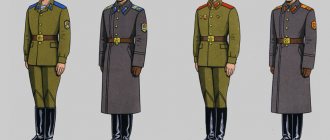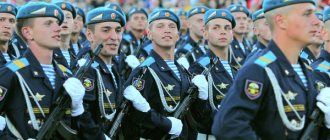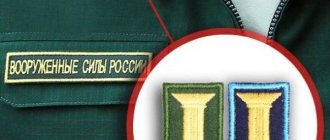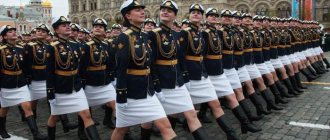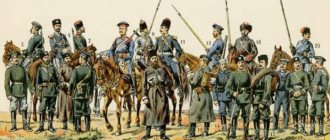Sample menu for every day
Meals in the army are mainly three times a day: breakfast, lunch and dinner.
Breakfast
- a plate of porridge with a sausage or cutlet (or a portion of dumplings or dumplings with cottage cheese - at least once a week);
- a glass of milk;
- coffee with a spoon of condensed milk or sugar.
If such a breakfast seems too meager to your mother, remember how the future recruit disappeared for the whole day after drinking half a glass of tea! The menu cannot be called too abundant, but this amount of food is quite enough to invigorate the young body and set it up for work.
Dinner
- without fail, soldiers are fed the first course - cabbage soup, borscht or solyanka, rassolnik or noodle soup;
- for the second course they give a meat dish of beef, pork, liver or chicken fillet with some side dish;
- a serving of vinaigrette or salad from fresh seasonal vegetables is a healthy and tasty addition to any lunch;
- For dessert there is a glass of fresh fruit compote or uzvar with a pack of crackers.
Dinner
- fish - fried, boiled or stewed (mackerel sometimes), and with it - a portion of mashed potatoes, stewed cabbage, rice or buckwheat porridge with butter; dumplings with sour cream and peas/corn garnish
- a glass of tea or juice, accompanied by a bun or other pastry on weekends.
In addition, every soldier is given a pack of butter, white and gray bread every day.
Don’t forget about vitamins: fresh and sauerkraut, raw and pickled cucumbers and tomatoes. Legumes are often given, which are a valuable source of vegetable protein.
When compiling the daily menu in the army, the preferences of the majority of soldiers are taken into account. Dishes that are not particularly popular are rarely prepared: the guys should not leave the table hungry. So, pearl barley is not often served, but buckwheat porridge as a side dish for a cutlet or sausage appears on the soldier’s table several times a week.
To tell the truth, not everyone likes fish. But here it’s a completely different matter: whether you like it or not, you’ll have to eat it, as it’s the order of your senior in rank. Well, it’s not like hunger!
As you can see, the general military ration is quite high in calories - on average it is 4300-4600 kilocalories per day.
What has changed in the diet of a modern conscript soldier in recent years?
Nutrition in the army, as well as military service in general, is always surrounded by myths that often do not correspond to reality. For many, the soldier's table is associated exclusively with viscous, inedible pearl barley, stale bread and stew.
Often, having heard the memories of those who served many years ago about the difficult daily routine in the army, excessive physical exertion, terrible conditions and meager food, recruits, together with their relatives, prefer to find ways to escape in order to avoid the upcoming trials.
Read more about how difficult the daily routine in the army really is in our article.
There is a lot of conflicting information about what soldiers are fed today. Some sources claim that nothing has changed with the reforms, and young people are malnourished, literally starving, others claim that modern conscripts have the opportunity to independently choose from the proposed menu and introduction to parts of the “Buffet”.
What you can believe:
- Indeed, the diet in the army has become more varied and rich. You’ll have to forget about homemade pickles and grandma’s pies for the year of service, but you definitely won’t have to go hungry.
- The beloved sausages, dumplings, dumplings and coffee with milk are now not uncommon in the soldier’s diet.
- It is also true that in many parts there is a possibility of choice. The soldier can take the first and second according to his taste, choosing from the offered assortment. The menu may include 2 soups and a couple of side dishes with different meat products.
- "Buffet" is rather an exception to the rule, which can be found only in some parts.
- Food preparation is now carried out by civilian personnel, which has a positive effect on the quality and taste of the dishes. Professional chefs undoubtedly do a better job than soldiers, as was the case in the past.
However, it is worth noting that the innovations did not affect all parts. As a rule, the larger the item, the better the catering. Also, promises that millet and pearl barley will be present only in first courses do not coincide with reality: cereals are also invariably present on the menu in the form of porridges.
One thing is certain: not a single conscript will go hungry. The food of soldiers in the Russian army strictly complies with established standards, containing all products that provide the young body with everything necessary. A balanced diet and three meals a day on a schedule completely replenish the energy expended.
Packed rations
Dried rations are issued if there are no opportunities or conditions for eating in the canteen. It is issued during exercises outside the unit's territory. IRP contains food intended for preparation in the field. An individual food ration, or dry ration as it is also called, is issued as a temporary replacement for a field kitchen.
When preparing dry rations, the following rules are taken into account:
- There should be no perishable products present;
- Food should be ready to eat when heated, or, in extreme cases, be quick to cook;
- All dishes should be easily digestible by the body;
- Availability of convenient and durable packaging with protection from dirt and water;
- Availability of the right amount of calories, vitamins and nutrients.
All these requirements are of great importance when military personnel are in the field. There are several different types of dry soldering. A typical soldier's kit includes:
- Canned stew, porridge, stew, condensed milk;
- In dried or freeze-dried form, various soups and borscht, as well as coffee, juices, dried fruits and powdered milk;
- Spices, sugar and vitamins;
- Biscuits and crackers.
The composition also includes wet and dry wipes, a set of disposable tableware, water purification tablets, Taganka matches and dry fuel for heating food.
The following is prohibited from being included in the individual diet:
- Food with limited storage conditions;
- Products that contain alcohol, cooking oils, and almost all preservatives;
- Confectionery products with a cream base and a large amount of cocoa powder;
- Any non-certified products.
The dry rations provide everything for a complete meal for military personnel.
What does a soldier's breakfast consist of in 2021?
Having worked up an appetite after the mandatory morning exercises, the fighters receive a full breakfast consisting of:
- pasta, or porridge cooked from oatmeal, buckwheat, millet, rice or pearl barley;
- The side dish usually includes sausages, meat cutlets, chicken or goulash made from liver;
- addition in the form of butter, processed cheese, sometimes a boiled egg;
- sweet coffee (or cocoa), diluted with natural or condensed milk;
- for dessert: waffles/cookies/gingerbread or a fresh bun.
Once a week, a portion of dumplings is included in the menu for conscripts.
If such a set seems meager to someone, then practice shows that most recruits have difficulty eating an impressive portion of high-calorie foods.
Buffet
And finally, about what the stern grandfathers of modern soldiers would consider an unaffordable luxury: the ability to choose one or another dish from several offered - the well-known and beloved “buffet”.
Of course, such a system is not implemented everywhere, but if you are lucky enough to encounter such a phenomenon, you probably won’t regret it!
Coming to lunch, a soldier can choose one of two soups, one of three hot dishes and any of three side dishes. If you want to try, say, both chicken and goulash, no one will object, but you need to take half of it, not the full portion. You can also put half portions of two side dishes on a plate.
A much-loved new addition was the salad bar. In the past, many soldiers would refuse salads if they contained a food item they didn't like. Now this problem has been solved: you can make salads yourself from what you have, seasoning them with vegetable oil, sauce, or, as some prefer, simply mixing your favorite vegetables in a plate.
As parents of conscripts can see, food in the army has not only become more varied. The portions have also become larger, not to mention the quality of the prepared dishes - it is beyond praise. Particular attention is paid to the behavior of soldiers at the table.
Vodka and caviar
- We talked about the snack, now let's talk about the drink! Is the Russian army going to return to the practice of issuing “wine rations,” as it was called before the revolution, or “People’s Commissar 100 grams”?
— First, let's understand the very concept of “People's Commissar 100 grams.” It appeared in January 1940 during the Soviet-Finnish War. Then People's Commissar of Defense Voroshilov turned to Stalin with a request to give soldiers and commanders of the Red Army 100 g of vodka and 50 g of lard for snacks due to the difficult weather conditions on the Karelian Isthmus. The frosts there actually reached -40 Celsius. During the Great Patriotic War, vodka was issued to the troops (only in the active army!) in order to raise morale already in July 1941. Although the decree of the State Defense Committee itself, classified as “secret”, was signed by Stalin only in August. O in May 1945 after the victory over Germany and was never resumed. Many front-line soldiers write in their memoirs that vodka contributed to the Victory. But I would like to note on my own that daily consumption of strong alcohol, apart from the appearance of improving the psychological state, does not have any other positive effect on the soldier’s body.
Article on the topic
“Narkomov’s 100 grams”. How alcohol influenced the outcome of the war Another thing is red wine, which is included in the rations of submariners in the same amount of 100 grams. Of course, only while they are at sea. Doctors believe that in such quantities it stimulates the circulatory system, which is extremely necessary for all submariners, regardless of rank, since they work under large pressure differences. Since we’re talking about submariners, it’s worth saying that their diet also includes chocolate, lemons, tomato juice, sour cream, cottage cheese, cookies, as well as condensed milk, balyk, herring, liver pate, and dietary poultry. And those who serve on nuclear submarines also receive red caviar.
Conclusion
When going to serve, recruits and their parents should not worry; the soldier is definitely not in danger of starvation. The diet in the Russian army provides everything necessary for a young body. For many young men, this variety is very different (for the better) from the usual menu in civilian life.
Guys who are too picky, of course, will have to forget about their gastronomic preferences for a year. But more often than not, being in the fresh air, a busy schedule and physical activity lead to the fact that all the soldiers happily gobble up the dishes offered and, returning home, can boast of a fit, muscular figure.
Is a hungry soldier a bad soldier?
On the question of which army fights better - well-fed or hungry - there are two points of view. If you ask a soldier about this, he will answer without hesitation that after a hearty lunch there is no fear of dying. The best confirmation of this is the words attributed to King Frederick II of Prussia: “An army, like a snake, moves exclusively on its belly.” However, according to the well-known principle, the speed of a column is determined by its slowest link. In all centuries, such a convoy with provisions was considered, which slows down the speed of the advance of troops. The expression of the great Russian commander Alexander Vasilyevich Suvorov fits perfectly into the concept of this point of view: “The main thing is speed and onslaught! Your bread is in the enemy’s baggage train and backpacks.”
Before the First World War, the question of soldiers' diets had never been more pressing, and although the war itself did not provide a concrete answer, it clearly demonstrated the advantages and disadvantages of both approaches. It is what the soldiers ate in the trenches of the First World War that will be discussed in the article.
A French soldier snacks on bread (https://www.worldwar1gallery.com)
Horse meat, sir!
According to official documents, in 1914 the daily ration of a British soldier consisted of the following products (for ease of comparison, all values are given in the metric system):
- Canned meat – 450 grams;
- Bread – 560 grams (could be replaced with 113 grams of oatmeal or rice);
- Cheese – 85 grams (half of one tin package);
- Smoked pork – 113 grams (could be replaced with the same portion of butter or canned meat);
- Fresh vegetables – 226 grams (could be replaced with 56 grams of dried vegetables)
- Canned vegetables and meat – 566/680 grams (depending on the size of the can);
- Tea – 18 grams (in special cases, replaced with 9.5 grams of chocolate powder);
- Salt – 14 grams;
- Sugar – 85 grams;
- Jam – 113 grams.
Also, if possible, the soldiers should have been provided with a small amount of pepper, mustard and tobacco, and on holidays - chocolate. However, in practice, everything did not look so appetizing. The fact is that Great Britain had to use sea routes where German submarines operated to deliver food to the front, so during all the years of the war, British units fighting in France and Belgium received approximately 3.5 million tons of food. This figure, of course, looks quite impressive, but for the troops it was a drop in the ocean. Another option was purchasing food from the local population, but residents of the front line most often struggled to make ends meet themselves. Therefore, the real ration of the soldiers of Foggy Albion looked like this: 283 grams of bread (most often it was replaced with biscuits), 170 grams of meat (usually these were the remains of horses killed on the battlefield, but more often there was no meat at all and it was replaced with canned beans), 170 grams of vegetables (which were used mainly for soup, to which semi-edible weeds such as nettles were also added), 28 grams of tobacco or a pack of cigarettes. In addition, soldiers were always provided with hot tea, the brew for which was sometimes diluted with dried herbs and vegetables.
Part of the British Ration (https://www.oryansroughnecks.org)
Interesting fact: Despite all the difficulties with nutrition, British soldiers were pampered every day with a portion of lime or lemon juice. Besides being a rather pleasant addition to a rather meager and perhaps not the most palatable diet, citrus juice also served as a preventative measure against infections and diseases caused by trench life.
An English soldier snacks before battle (https://www.retrosnapshots.com)
Secrets of Trench Cooks: British Potato Soup (serves 10 people). Pour 12 liters of water into the cauldron, put two kilograms of meat and half a bucket of peeled and chopped potatoes there. Add about 100 grams of fat or half a stick of butter. To make the soup thicker, during the cooking process add about half a glass of flour, as well as 10 cups of barley (if there is no barley, oatmeal will do). Towards the end of cooking, add parsley, parsnip and celery roots. Salt and pepper to taste.
Cooking Christmas goose (https://www.worldwar1gallery.com)
French trenches menu.
In the period from 1914 to the beginning of 1915. The rations of the French field kitchen did not reach European standards, but then, through the efforts of the quartermasters, the French managed not only to catch up, but also to surpass all the warring countries in terms of the quality of food supplied to the front. There is an opinion that none of the armies of the First World War ate as well as the French. Since 1915, rations of three categories were introduced: regular, reinforced and emergency. The usual ration included the following products:
- Bread – 750 grams (could be replaced with 650 grams of biscuits);
- Beef/pork – 400 grams (could be replaced with 300 grams of canned meat);
- Corned beef/smoked meat – 210 grams;
- Fat/lard – 30 grams;
- Dry soup concentrate – 50 grams;
- Rice/dried vegetables – 60 grams;
- Coffee – 24 grams;
- Salt – 24 grams;
- Sugar – 34 grams;
- Wine - 500 grams (sometimes replaced with a liter of beer or cider). By the middle of the war, the norm was raised to 750 grams. Soldiers were also not forbidden to buy alcohol from the local population;
- Tobacco – 20 grams.
The enhanced ration included all the same products plus another 50 grams of fresh meat, 40 grams of rice and 16 grams of sugar and coffee. The emergency ration was a kind of emergency supply and was stored not with the quartermaster, but in the soldiers' backpacks, so quite often soldiers exchanged products among themselves, based on personal preferences, but in its original version it looked like this:
- Biscuits – 500 grams;
- Canned meat - 300 grams (since the canned food was brought from Madagascar, it was believed that they were made from monkey meat. As a result, the canned meat was called “monkey”);
- Rice/dried vegetables – 160 grams;
- Soup concentrate – 50 grams (two briquettes of 25 grams each, most often it was chicken broth with pasta or beef soup with vegetables/rice);
- Salt – 48 grams;
- Sugar – 80 grams;
- Coffee tablets – 2 pieces (36 grams);
- Chocolate – 125 grams.
This ration also included alcohol, approximately 0.5 liters of rum per company. This inviolable bottle was kept by the sergeant.
Despite all these delights, most of the soldiers sitting in the trenches were content with cold food. The fact is that it was necessary to send someone to the field kitchen for hot food, and this task was considered a very dangerous task. Most of these “walkers” on the way to the field kitchen and back became an excellent target for enemy soldiers. Therefore, the menu in the French trenches more often included meat fried over a small fire or coals (allowed quite rarely), salted fish (sometimes inedible from a large amount of salt), as well as everything that could be prepared from fat, meat waste, dried vegetables and rice. The only thing that kept French gourmets going was a good portion of cheap soldiers’ wine or beer.
Part of the French ration (https://ariestink.wix.com)
Interesting fact: France entered World War I without a centralized field kitchen. The French army headquarters decided that they had no right to force soldiers to eat the same thing every day, so each platoon had its own field kitchen kits. The soldiers agreed on what they wanted to eat that day and prepared it from the food packages they were given and what was sent to them from home. These bonfires of gastronomic democracy became an excellent reference point for German snipers, and as a result, after a large number of losses, the French army’s supplies were forced to unify the process of feeding soldiers.
Sometimes they ate hot food... (https://darkroom.baltimoresun.com)
Secrets of trench cooks: Universal vegetable mixture for soldier's soup.
Finely chopped dried vegetables used to make soups were typically pressed into slabs weighing about a kilogram. At the start of the war, in each country they consisted of approximately the same vegetables, only their ratio and method of drying differed. In Russia, as a rule, a traditional oven was used for this. If you suddenly decide to try to do it yourself, here is the composition of a standard soldier's vegetable briquette, which has not changed since the end of the 19th century: cabbage - 200 grams, carrots - 200 grams, beets - 150 grams, turnips - 150 grams, onions - 150 grams, green onions – 50 grams, celery – 50 grams, parsley – 50 grams.
...but more often I had to eat like this (https://14-18.ru)
American casual.
Even before entering the war, the United States supplied all the warring powers with various supplies. Basically, this was done in debt, but the transition of the war to the positional stage aroused in the hearts of most entrepreneurs the fear that the war would drag on so long that none of the debtors, after its end, would simply be able to pay for what they had purchased. According to some historians, it was entrepreneurs who pressured the government into forcing the United States to enter the war in 1917. The Entente was chosen as the side, which by that time was clearly gaining the upper hand. Thanks to a well-thought-out ration system, none of the American soldiers experienced hunger. Their diet was divided into three types: reserve, trench and emergency.
Spare rations were intended for those times when the field kitchen was out of reach. It was daily and was calculated for one fighter. It included:
- Canned meat - 450 grams (most often it was corned beef);
- Canned bread – 2 cans of 220 grams each;
- Sugar – 68 grams;
- Roasted ground coffee – 32 grams;
- Salt – 4.5 grams.
Although such a ration looked rather meager at first glance, it provided the soldier with 3,300 calories, which is only a thousand calories less than the standard daily ration of a Russian soldier (4,300 calories).
Trench rations were supplied at the rate of “25x1”, that is, 25 soldiers for one day, or one soldier for 25 days. This ration was sealed in a bag that was placed in a massive galvanized container, which, once opened, could not be resealed. Such precautions were aimed at protecting products from the effects of poisonous gases. The standard contents of this ration were as follows: several cans of canned food (beef stew, corned beef, salmon and sardines); salt, sugar, instant coffee, cigarettes and strong alcohol. Most of the food from this diet had to be heated before consumption, but soldiers were always quite unpretentious people and often ate it all cold.
Emergency rations were intended for those cases when a soldier would not be able to support his strength in any other way. It consisted of bars made from a mixture of beef flour and boiled wheat (three pieces, 85 grams each) and three chocolate bars, 28 grams each. All this was placed in a small oval box and placed in a special pocket of a soldier’s uniform. It was these rations that became the basis for the creation of modern emergency kits for US Air Force pilots.
According to historians, during the period of its participation in the war, the US government spent 727,092,430 dollars and 44 cents on rations for its soldiers (approximately 12 billion in modern money).
Advertising instant coffee during the First World War (https://kykyryzo.ru)
Interesting fact: Instant coffee, which was invented by Belgian emigrant George Washington in 1906, was very popular with the American military, since it was easier to prepare than ground coffee, but it gave a similar invigorating effect (here, of course, one can argue). A special coffee department was also created at the US War Department. Employees of this department found that instant coffee plays an important role in restoring the body after soldiers were exposed to mustard gas. The soldiers nicknamed this invention "George's mug."
American soldiers on vacation (https://fineartamerica.com)
For Faith, the Tsar and Calories!
At all times, the diet of a Russian soldier was not particularly varied or delicious, but it was always satisfying. This was due to the climatic conditions of our country and the preferences of the soldiers, who, for the most part, came from villages. By the way, the soldiers of pre-revolutionary Russia ate much more nutritiously than the soldiers of the Red Army. The daily ration of a soldier of the Russian Imperial Army was as follows:
- Rye bread – 1 kg (could be replaced with 700 grams of rye crackers);
- Cereals – 100/200 grams (depending on the place of service);
- Meat – 400 grams (could be replaced with 300 grams of canned meat);
- Vegetables – 250 grams (if replaced with dried vegetables, then 20 grams)
- Butter/lard – 20 grams;
- Flour – 17 grams;
- Tea – 6.4 grams;
- Sugar – 20 grams;
- Pepper – 0.7 grams.
During religious fasts, meat was replaced with river fish, which was most often served dried. On such days they put mushrooms in soups. In the first period of the war, the soldiers' rations were increased - for example, meat per person was now 615 grams. However, with the beginning of trench warfare, the diet had to be cut back and sometimes the meat had to be replaced with corned beef. If you look at the picture as a whole, the tsarist government managed to maintain the standards of food supplies, but the quality of these same products dropped significantly. The point here is not even the hardships of war and the devastation of villages, but our second primordially Russian problem - roads. Without any more or less developed transport infrastructure, the quartermasters had to regularly deliver cow carcasses to the front over ruts and potholes (by the way, one combat company killed a whole bull a day), hundreds of thousands of tons of flour, canned food and vegetables, and all this without the help of the then absent refrigeration industry. Bringing rotten food to the front was a fairly common thing. In Soviet historiography, quartermasters are blamed for this state of affairs, although in fact they were most often not to blame for the spoilage of food.
Russian field bakery (https://russiahistory.ru)
Interesting fact: During the war, problems with bread began in the Russian army, since baking a kilogram per soldier per day in a field kitchen turned out to be almost impossible. Therefore, the soldiers were given crackers, but these were not the small cubes that we were so accustomed to. A soldier's rusk, in fact, was a dried loaf of ordinary bread, which was convenient to transport.
Cabbage soup and porridge are our food (https://diletant.ru)
Secrets of trench cooks: Soldier's cabbage soup. A bucket of water (about 12 liters) is poured into the boiler. Next add about two kilograms of meat and about a quarter of a bucket of sauerkraut. Approximately 5-10 cups of cereal are added - it will add greater thickness to the soup. For these purposes, oatmeal, buckwheat or barley groats are best suited. After this, you need to add 1.5 kilograms of flour to the cauldron for the same purposes. Salt, pepper, bay leaf and onion to taste. All this is cooked for three hours. If time permits, after cooking you can let it sit for another one to two hours. For those who are surprised by the absence of potatoes in the soup: the fact is that 100 years ago the vegetable was not as common in Russia as it is now, and was not included in the mandatory soldier’s ration.
Field kitchen of the 2nd squadron of the 15th Hussars Ukrainian Regiment. Poland, 1914 (https://archives.ru)
Surrogate ration.
While Russian Ivan slurped cabbage soup and the French indulged in ratatouille, a German soldier fighting on two fronts looked at them with hungry eyes. The German trench menu was meager and dull, as, in fact, was the fate of the entire German people during this period. According to rough estimates, initially the average German soldier's diet was approximately 3,500 calories per day, and towards the end of the war it barely reached 1,600 calories. Even on paper, the German’s standard daily ration looked sad:
- Erbswurst soup concentrate – 2 packs of 130 grams each;
- Bread – 250 grams;
- Smoked pork – 150 grams;
- Coffee – 25 grams (or 3 grams of tea);
- Sugar – 25 grams;
- Salt – 25 grams.
The hungriest army of the First World War (https://www.bbc.co.uk)
The trench menu looked no better:
- Bread – 751 grams;
- Biscuits – 496 grams;
- Egg powder – 397 grams;
- Potatoes – 1.5 kilograms;
- Fresh vegetables – 128 grams (could be replaced with 56 grams of dried vegetables);
- Cigars – up to 2 pieces per day.
However, by the end of 1915, even these standards were not observed. The dying German food industry began to actively use surrogates. For example, potatoes were replaced by rutabaga, butter was replaced by margarine, sugar by saccharin, and barley or rye was brewed instead of coffee. Moreover, there was an acute shortage of bread, the production of which now used rutabaga and cellulose. The soldiers were also entitled to alcohol, which was issued at the discretion of the commanders. The command forbade drinking on the march, but in the trenches the soldiers sometimes got drunk to the point of unconsciousness.
Dry pea soup concentrate (https://www.passionmilitaria.com)
Interesting fact: The Germans created their own food crisis. The point is not only that most of the peasants went to war, but that in the first years of the First World War all pigs were exterminated, as they ate potatoes, which were scarce at that time. In 1916, due to bad weather conditions and a shortage of farmers, almost the entire potato crop was lost, and famine began in the country. By the way, those who lived to see the famine of 1945 said that in 1917 it was much worse.
German soldiers caught rats for dinner (https://australianidentity2012.weebly.com)
Gastronomic compromise.
The Austro-Hungarian Empire included about eleven nationalities. They all differed in their culture and, therefore, had different culinary preferences. However, the supplies managed to create a standard diet for the army. Rations here were called portions, and there were three of them: full, regular and emergency. The full portion was intended for soldiers in the rear services and those who were not currently taking part in hostilities. It consisted of:
- Bread/biscuits – 700 grams;
- Beef – 400 grams;
- Fresh vegetables – 140 grams;
- Ground coffee – 2 cans of 46 grams each;
- Tobacco – 36 grams.
The so-called “regular portion” was intended for soldiers on the march. It consisted of the same products, but in smaller quantities. This was explained by the fact that such soldiers have less time to prepare and consume food. For example, only 100 grams of vegetables per soldier per day, and 18 grams of tobacco per day.
The emergency portion was designed for soldiers who do not have access to a field kitchen. Such rations were stored in hiking backpacks and opened only in case of urgent need. Here is the composition of this portion:
- Bread/crackers/biscuits – 200 grams;
- Canned meat - one 400 gram can (pork or beef stew, and at the end of the war, minced sausage);
- Ground coffee – 92 grams;
- Tobacco – 18 grams;
- Salt – 30 grams.
By the end of the war, Austria-Hungary began to experience the same difficulties as Germany, however, unlike its ally, it continued to feed prisoners of war in accordance with the Geneva and Hague Conventions almost until 1917, that is, in the same way as its soldiers. Even after the prisoners' diet was revised, it still remained better than that of those who languished in German captivity.
Part of the Austrian ration (https://17thdivision.tripod.com)
Interesting fact: A rear service soldier could also receive, in addition to his “full portion,” 30 grams of salt, 0.5 grams of black pepper or paprika, 20 grams of butter or fat, 1 gram of special seasoning for soup, onion or garlic no more than 5 grams , 2 milliliters of vinegar and half a liter of wine. It was forbidden to give alcohol to the rest of the soldiers. The officer also had a choice of 5 cigars or 25 cigarettes.
Austro-Hungarian field kitchen (https://www.iwm.org.uk)
Since the First World War, much has been revised in the issue of nutrition for soldiers, and much of the credit for this goes to scientists who have developed many ways to extend the shelf life of food and make it more portable without losing its taste and nutritional qualities. However, the question of which soldier fights better, well-fed or hungry, still remains open, and evidence of this is the differences in calorie content and content of army rations in different countries.
Eat more vegetables! Save meat and wheat for our soldiers and allies! (https://qw88nb88.wordpress.com)
What do soldiers eat during training?
The service involves conducting exercises outside the territory of a military unit, during which soldiers cannot visit the canteen for meals. But this does not mean that the soldiers remain hungry. In this case, each young person receives a dry ration, excluding any perishable products or those that require additional preparation.
The dry pack consists of:
- breadcrumbs, crackers, jam;
- canned food: stewed meats, ready-made porridges with meat, condensed milk;
- small packets of sugar and pepper, vitamins;
- freeze-dried soups for instant preparation, powdered milk, instant juice, coffee, dried fruits;
- disposable tableware, napkins and a simple device for heating food and a means for quickly purifying water.
All components are securely packaged. Products in rations constitute the soldier’s daily ration, or are designed for a single meal. Shelf life and packaging integrity are carefully monitored.
If soldiers have to live for a certain time at training grounds in established tent cities, three meals a day are organized using a field kitchen. Of course, the diet in such conditions is not very varied, but the soldiers always receive hot food.

